Standard Costing: Analysis, Variances, and Control in Finance
VerifiedAdded on 2022/08/13
|6
|1784
|20
Report
AI Summary
This report delves into the concept of standard costing, a crucial method for comparing actual output costs with predetermined standards to identify variances and inform management for corrective actions. It outlines the process of establishing standards, determining actual costs, comparing them, identifying variance causes, and disposing of variances. The report further examines factors influencing favorable and unfavorable material and labor variances, supported by a numerical example. Finally, it critically analyzes standard costing as a control tool, discussing its suitability for mass production, limitations in small batch or service-oriented businesses, and challenges in variance analysis and responsibility assignment. The report concludes by emphasizing standard costing's role in planning, controlling costs, and performance evaluation while acknowledging its limitations in certain contexts and the importance of employee involvement in budget setting.
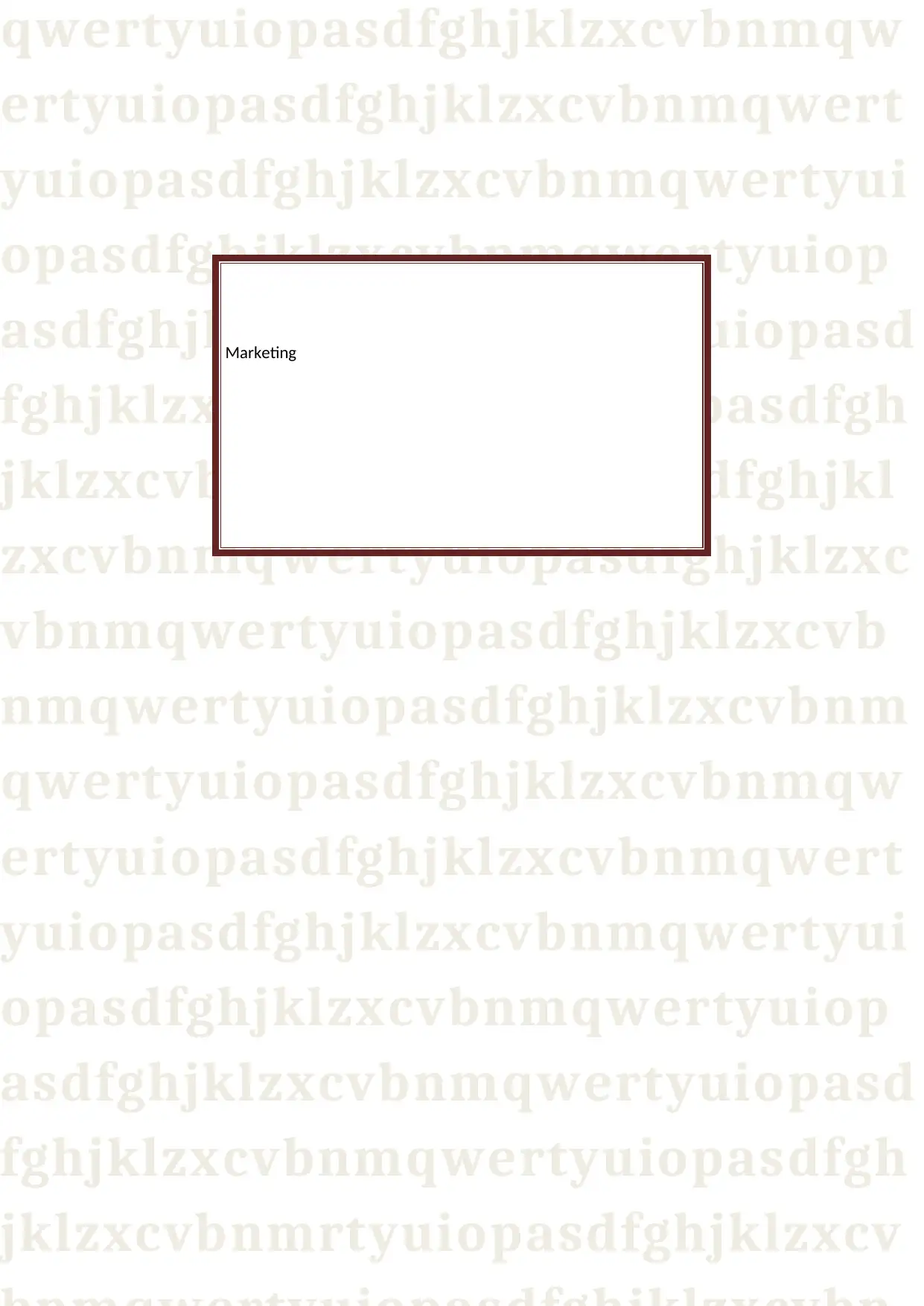
qwertyuiopasdfghjklzxcvbnmqw
ertyuiopasdfghjklzxcvbnmqwert
yuiopasdfghjklzxcvbnmqwertyui
opasdfghjklzxcvbnmqwertyuiop
asdfghjklzxcvbnmqwertyuiopasd
fghjklzxcvbnmqwertyuiopasdfgh
jklzxcvbnmqwertyuiopasdfghjkl
zxcvbnmqwertyuiopasdfghjklzxc
vbnmqwertyuiopasdfghjklzxcvb
nmqwertyuiopasdfghjklzxcvbnm
qwertyuiopasdfghjklzxcvbnmqw
ertyuiopasdfghjklzxcvbnmqwert
yuiopasdfghjklzxcvbnmqwertyui
opasdfghjklzxcvbnmqwertyuiop
asdfghjklzxcvbnmqwertyuiopasd
fghjklzxcvbnmqwertyuiopasdfgh
jklzxcvbnmrtyuiopasdfghjklzxcv
Marketing
ertyuiopasdfghjklzxcvbnmqwert
yuiopasdfghjklzxcvbnmqwertyui
opasdfghjklzxcvbnmqwertyuiop
asdfghjklzxcvbnmqwertyuiopasd
fghjklzxcvbnmqwertyuiopasdfgh
jklzxcvbnmqwertyuiopasdfghjkl
zxcvbnmqwertyuiopasdfghjklzxc
vbnmqwertyuiopasdfghjklzxcvb
nmqwertyuiopasdfghjklzxcvbnm
qwertyuiopasdfghjklzxcvbnmqw
ertyuiopasdfghjklzxcvbnmqwert
yuiopasdfghjklzxcvbnmqwertyui
opasdfghjklzxcvbnmqwertyuiop
asdfghjklzxcvbnmqwertyuiopasd
fghjklzxcvbnmqwertyuiopasdfgh
jklzxcvbnmrtyuiopasdfghjklzxcv
Marketing
Paraphrase This Document
Need a fresh take? Get an instant paraphrase of this document with our AI Paraphraser
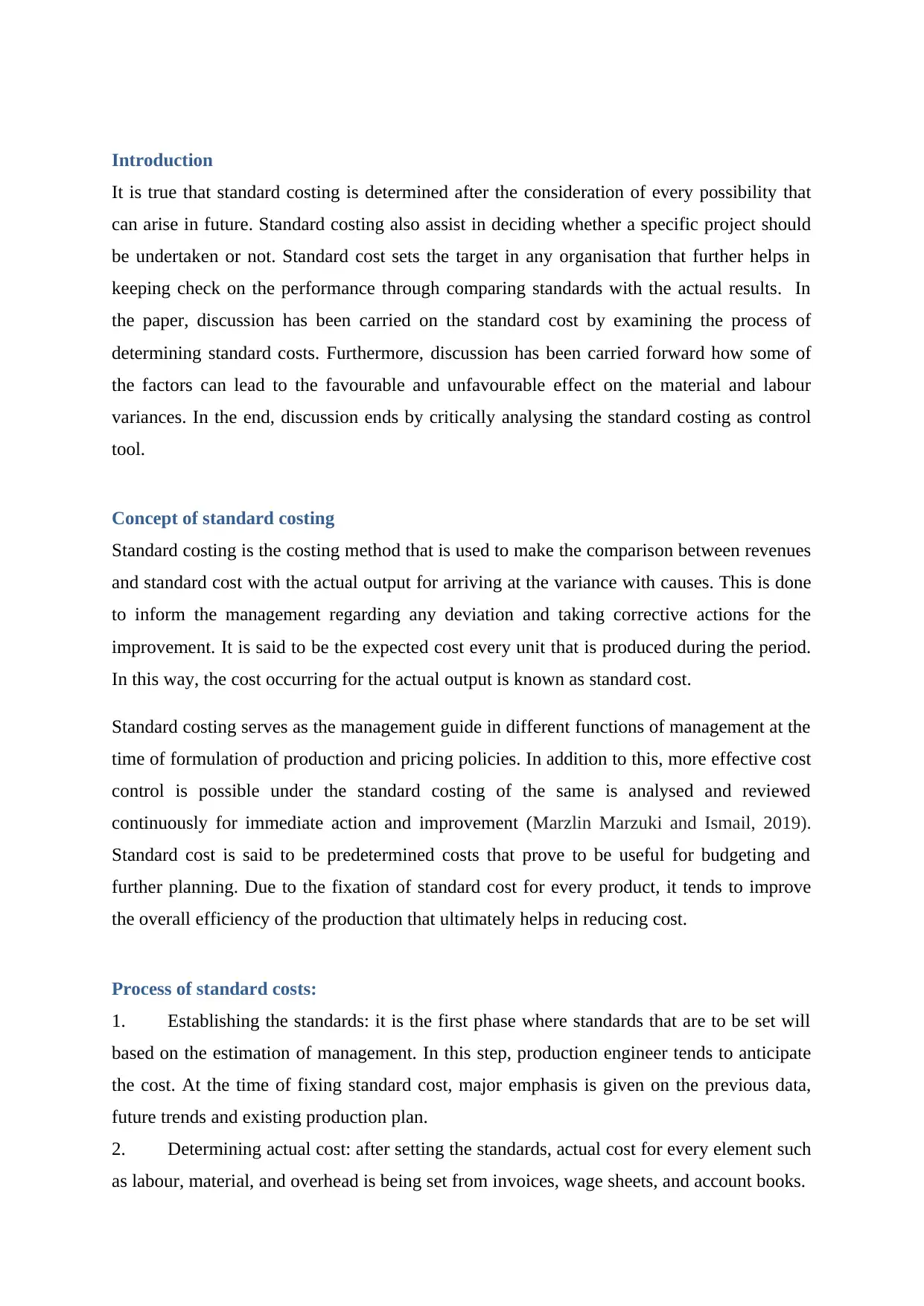
Introduction
It is true that standard costing is determined after the consideration of every possibility that
can arise in future. Standard costing also assist in deciding whether a specific project should
be undertaken or not. Standard cost sets the target in any organisation that further helps in
keeping check on the performance through comparing standards with the actual results. In
the paper, discussion has been carried on the standard cost by examining the process of
determining standard costs. Furthermore, discussion has been carried forward how some of
the factors can lead to the favourable and unfavourable effect on the material and labour
variances. In the end, discussion ends by critically analysing the standard costing as control
tool.
Concept of standard costing
Standard costing is the costing method that is used to make the comparison between revenues
and standard cost with the actual output for arriving at the variance with causes. This is done
to inform the management regarding any deviation and taking corrective actions for the
improvement. It is said to be the expected cost every unit that is produced during the period.
In this way, the cost occurring for the actual output is known as standard cost.
Standard costing serves as the management guide in different functions of management at the
time of formulation of production and pricing policies. In addition to this, more effective cost
control is possible under the standard costing of the same is analysed and reviewed
continuously for immediate action and improvement (Marzlin Marzuki and Ismail, 2019).
Standard cost is said to be predetermined costs that prove to be useful for budgeting and
further planning. Due to the fixation of standard cost for every product, it tends to improve
the overall efficiency of the production that ultimately helps in reducing cost.
Process of standard costs:
1. Establishing the standards: it is the first phase where standards that are to be set will
based on the estimation of management. In this step, production engineer tends to anticipate
the cost. At the time of fixing standard cost, major emphasis is given on the previous data,
future trends and existing production plan.
2. Determining actual cost: after setting the standards, actual cost for every element such
as labour, material, and overhead is being set from invoices, wage sheets, and account books.
It is true that standard costing is determined after the consideration of every possibility that
can arise in future. Standard costing also assist in deciding whether a specific project should
be undertaken or not. Standard cost sets the target in any organisation that further helps in
keeping check on the performance through comparing standards with the actual results. In
the paper, discussion has been carried on the standard cost by examining the process of
determining standard costs. Furthermore, discussion has been carried forward how some of
the factors can lead to the favourable and unfavourable effect on the material and labour
variances. In the end, discussion ends by critically analysing the standard costing as control
tool.
Concept of standard costing
Standard costing is the costing method that is used to make the comparison between revenues
and standard cost with the actual output for arriving at the variance with causes. This is done
to inform the management regarding any deviation and taking corrective actions for the
improvement. It is said to be the expected cost every unit that is produced during the period.
In this way, the cost occurring for the actual output is known as standard cost.
Standard costing serves as the management guide in different functions of management at the
time of formulation of production and pricing policies. In addition to this, more effective cost
control is possible under the standard costing of the same is analysed and reviewed
continuously for immediate action and improvement (Marzlin Marzuki and Ismail, 2019).
Standard cost is said to be predetermined costs that prove to be useful for budgeting and
further planning. Due to the fixation of standard cost for every product, it tends to improve
the overall efficiency of the production that ultimately helps in reducing cost.
Process of standard costs:
1. Establishing the standards: it is the first phase where standards that are to be set will
based on the estimation of management. In this step, production engineer tends to anticipate
the cost. At the time of fixing standard cost, major emphasis is given on the previous data,
future trends and existing production plan.
2. Determining actual cost: after setting the standards, actual cost for every element such
as labour, material, and overhead is being set from invoices, wage sheets, and account books.
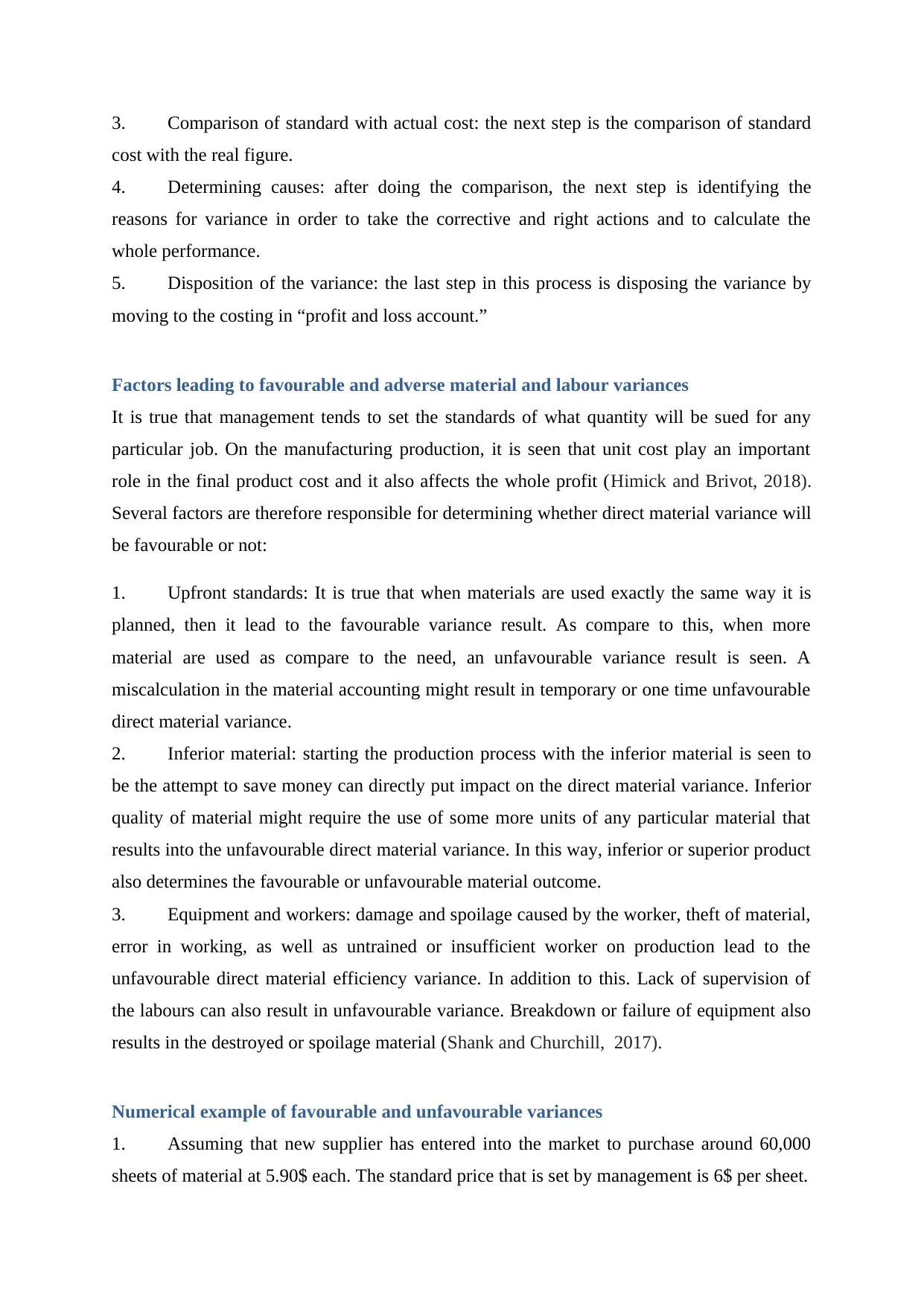
3. Comparison of standard with actual cost: the next step is the comparison of standard
cost with the real figure.
4. Determining causes: after doing the comparison, the next step is identifying the
reasons for variance in order to take the corrective and right actions and to calculate the
whole performance.
5. Disposition of the variance: the last step in this process is disposing the variance by
moving to the costing in “profit and loss account.”
Factors leading to favourable and adverse material and labour variances
It is true that management tends to set the standards of what quantity will be sued for any
particular job. On the manufacturing production, it is seen that unit cost play an important
role in the final product cost and it also affects the whole profit (Himick and Brivot, 2018).
Several factors are therefore responsible for determining whether direct material variance will
be favourable or not:
1. Upfront standards: It is true that when materials are used exactly the same way it is
planned, then it lead to the favourable variance result. As compare to this, when more
material are used as compare to the need, an unfavourable variance result is seen. A
miscalculation in the material accounting might result in temporary or one time unfavourable
direct material variance.
2. Inferior material: starting the production process with the inferior material is seen to
be the attempt to save money can directly put impact on the direct material variance. Inferior
quality of material might require the use of some more units of any particular material that
results into the unfavourable direct material variance. In this way, inferior or superior product
also determines the favourable or unfavourable material outcome.
3. Equipment and workers: damage and spoilage caused by the worker, theft of material,
error in working, as well as untrained or insufficient worker on production lead to the
unfavourable direct material efficiency variance. In addition to this. Lack of supervision of
the labours can also result in unfavourable variance. Breakdown or failure of equipment also
results in the destroyed or spoilage material (Shank and Churchill, 2017).
Numerical example of favourable and unfavourable variances
1. Assuming that new supplier has entered into the market to purchase around 60,000
sheets of material at 5.90$ each. The standard price that is set by management is 6$ per sheet.
cost with the real figure.
4. Determining causes: after doing the comparison, the next step is identifying the
reasons for variance in order to take the corrective and right actions and to calculate the
whole performance.
5. Disposition of the variance: the last step in this process is disposing the variance by
moving to the costing in “profit and loss account.”
Factors leading to favourable and adverse material and labour variances
It is true that management tends to set the standards of what quantity will be sued for any
particular job. On the manufacturing production, it is seen that unit cost play an important
role in the final product cost and it also affects the whole profit (Himick and Brivot, 2018).
Several factors are therefore responsible for determining whether direct material variance will
be favourable or not:
1. Upfront standards: It is true that when materials are used exactly the same way it is
planned, then it lead to the favourable variance result. As compare to this, when more
material are used as compare to the need, an unfavourable variance result is seen. A
miscalculation in the material accounting might result in temporary or one time unfavourable
direct material variance.
2. Inferior material: starting the production process with the inferior material is seen to
be the attempt to save money can directly put impact on the direct material variance. Inferior
quality of material might require the use of some more units of any particular material that
results into the unfavourable direct material variance. In this way, inferior or superior product
also determines the favourable or unfavourable material outcome.
3. Equipment and workers: damage and spoilage caused by the worker, theft of material,
error in working, as well as untrained or insufficient worker on production lead to the
unfavourable direct material efficiency variance. In addition to this. Lack of supervision of
the labours can also result in unfavourable variance. Breakdown or failure of equipment also
results in the destroyed or spoilage material (Shank and Churchill, 2017).
Numerical example of favourable and unfavourable variances
1. Assuming that new supplier has entered into the market to purchase around 60,000
sheets of material at 5.90$ each. The standard price that is set by management is 6$ per sheet.
⊘ This is a preview!⊘
Do you want full access?
Subscribe today to unlock all pages.

Trusted by 1+ million students worldwide
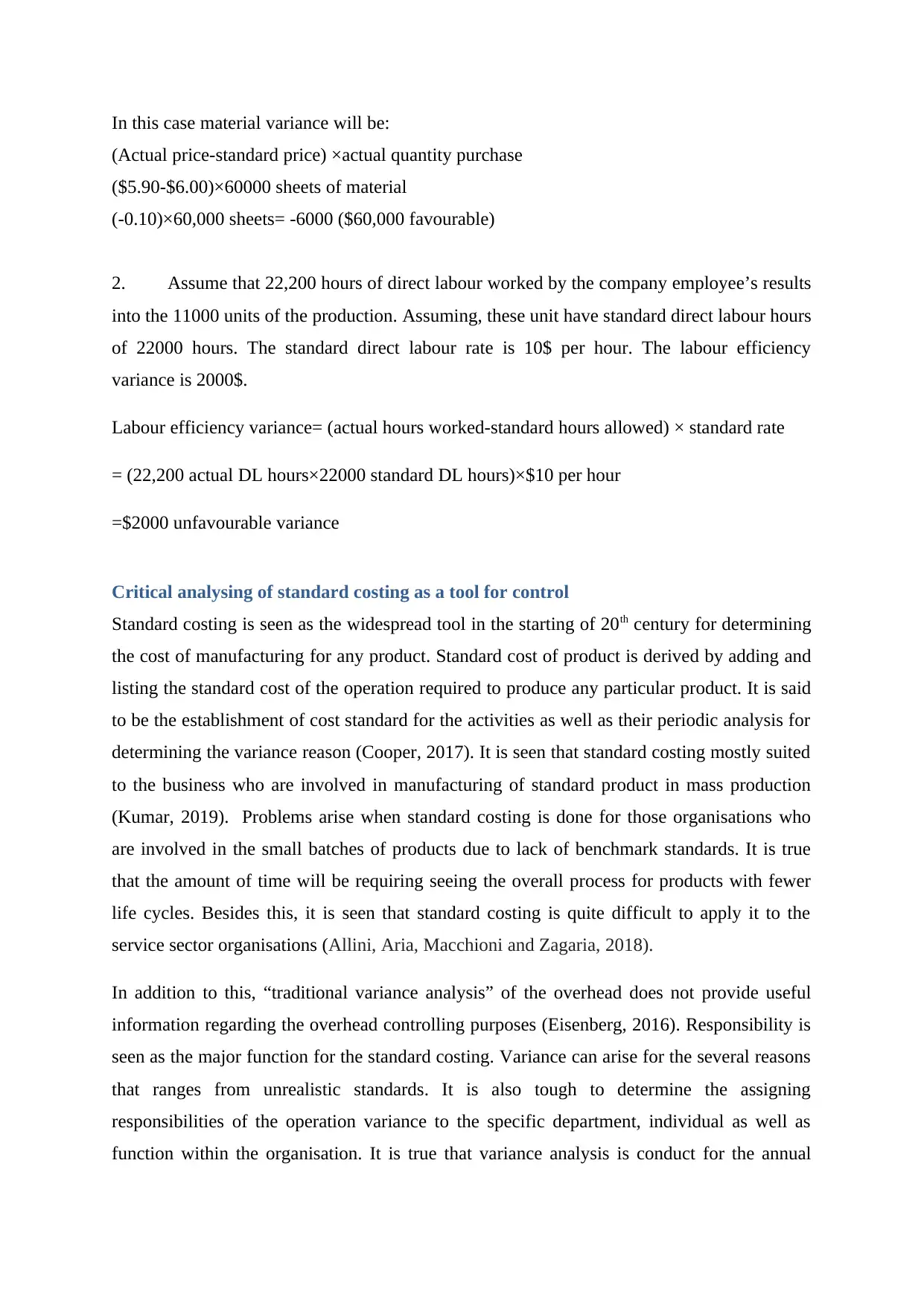
In this case material variance will be:
(Actual price-standard price) ×actual quantity purchase
($5.90-$6.00)×60000 sheets of material
(-0.10)×60,000 sheets= -6000 ($60,000 favourable)
2. Assume that 22,200 hours of direct labour worked by the company employee’s results
into the 11000 units of the production. Assuming, these unit have standard direct labour hours
of 22000 hours. The standard direct labour rate is 10$ per hour. The labour efficiency
variance is 2000$.
Labour efficiency variance= (actual hours worked-standard hours allowed) × standard rate
= (22,200 actual DL hours×22000 standard DL hours)×$10 per hour
=$2000 unfavourable variance
Critical analysing of standard costing as a tool for control
Standard costing is seen as the widespread tool in the starting of 20th century for determining
the cost of manufacturing for any product. Standard cost of product is derived by adding and
listing the standard cost of the operation required to produce any particular product. It is said
to be the establishment of cost standard for the activities as well as their periodic analysis for
determining the variance reason (Cooper, 2017). It is seen that standard costing mostly suited
to the business who are involved in manufacturing of standard product in mass production
(Kumar, 2019). Problems arise when standard costing is done for those organisations who
are involved in the small batches of products due to lack of benchmark standards. It is true
that the amount of time will be requiring seeing the overall process for products with fewer
life cycles. Besides this, it is seen that standard costing is quite difficult to apply it to the
service sector organisations (Allini, Aria, Macchioni and Zagaria, 2018).
In addition to this, “traditional variance analysis” of the overhead does not provide useful
information regarding the overhead controlling purposes (Eisenberg, 2016). Responsibility is
seen as the major function for the standard costing. Variance can arise for the several reasons
that ranges from unrealistic standards. It is also tough to determine the assigning
responsibilities of the operation variance to the specific department, individual as well as
function within the organisation. It is true that variance analysis is conduct for the annual
(Actual price-standard price) ×actual quantity purchase
($5.90-$6.00)×60000 sheets of material
(-0.10)×60,000 sheets= -6000 ($60,000 favourable)
2. Assume that 22,200 hours of direct labour worked by the company employee’s results
into the 11000 units of the production. Assuming, these unit have standard direct labour hours
of 22000 hours. The standard direct labour rate is 10$ per hour. The labour efficiency
variance is 2000$.
Labour efficiency variance= (actual hours worked-standard hours allowed) × standard rate
= (22,200 actual DL hours×22000 standard DL hours)×$10 per hour
=$2000 unfavourable variance
Critical analysing of standard costing as a tool for control
Standard costing is seen as the widespread tool in the starting of 20th century for determining
the cost of manufacturing for any product. Standard cost of product is derived by adding and
listing the standard cost of the operation required to produce any particular product. It is said
to be the establishment of cost standard for the activities as well as their periodic analysis for
determining the variance reason (Cooper, 2017). It is seen that standard costing mostly suited
to the business who are involved in manufacturing of standard product in mass production
(Kumar, 2019). Problems arise when standard costing is done for those organisations who
are involved in the small batches of products due to lack of benchmark standards. It is true
that the amount of time will be requiring seeing the overall process for products with fewer
life cycles. Besides this, it is seen that standard costing is quite difficult to apply it to the
service sector organisations (Allini, Aria, Macchioni and Zagaria, 2018).
In addition to this, “traditional variance analysis” of the overhead does not provide useful
information regarding the overhead controlling purposes (Eisenberg, 2016). Responsibility is
seen as the major function for the standard costing. Variance can arise for the several reasons
that ranges from unrealistic standards. It is also tough to determine the assigning
responsibilities of the operation variance to the specific department, individual as well as
function within the organisation. It is true that variance analysis is conduct for the annual
Paraphrase This Document
Need a fresh take? Get an instant paraphrase of this document with our AI Paraphraser
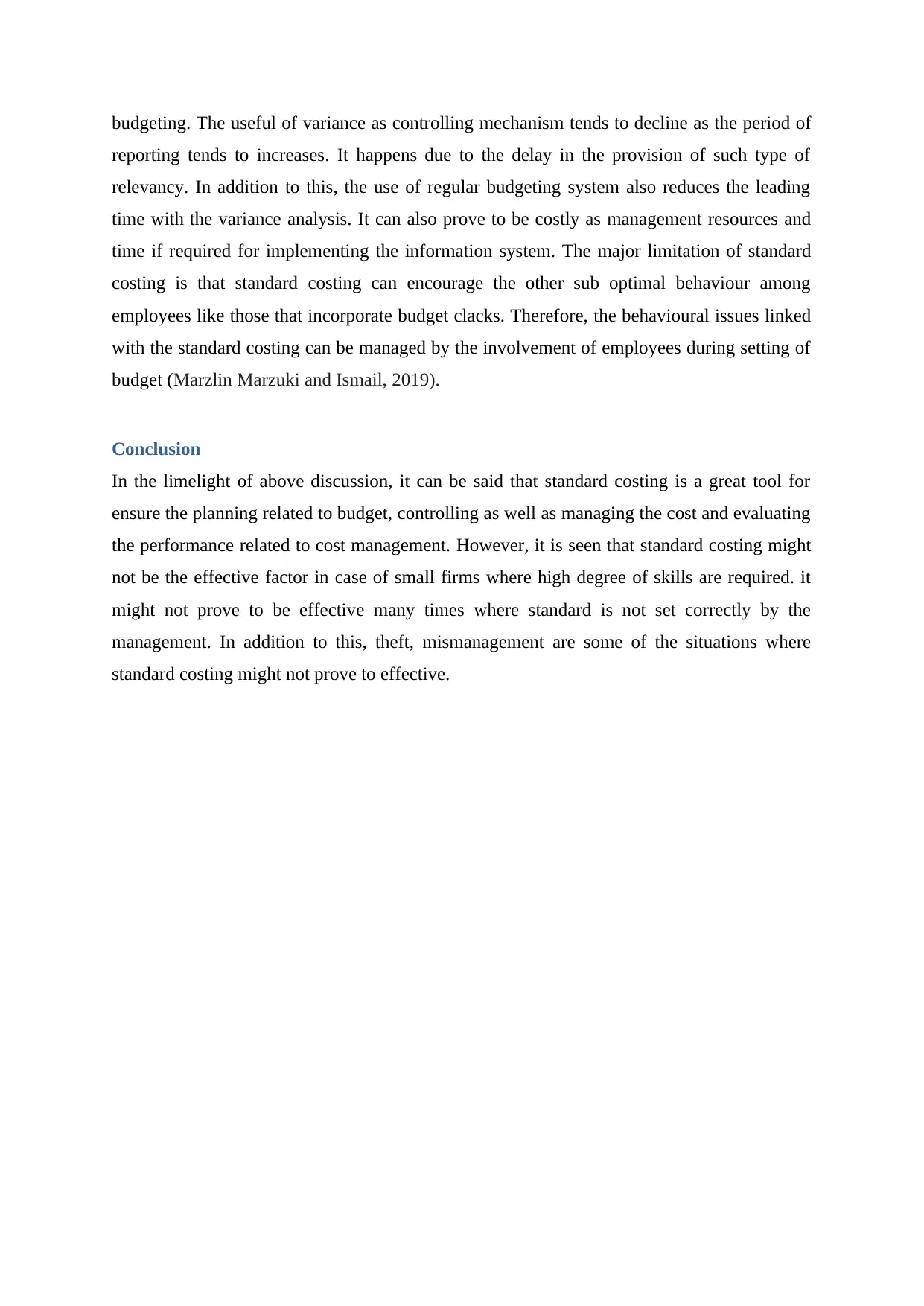
budgeting. The useful of variance as controlling mechanism tends to decline as the period of
reporting tends to increases. It happens due to the delay in the provision of such type of
relevancy. In addition to this, the use of regular budgeting system also reduces the leading
time with the variance analysis. It can also prove to be costly as management resources and
time if required for implementing the information system. The major limitation of standard
costing is that standard costing can encourage the other sub optimal behaviour among
employees like those that incorporate budget clacks. Therefore, the behavioural issues linked
with the standard costing can be managed by the involvement of employees during setting of
budget (Marzlin Marzuki and Ismail, 2019).
Conclusion
In the limelight of above discussion, it can be said that standard costing is a great tool for
ensure the planning related to budget, controlling as well as managing the cost and evaluating
the performance related to cost management. However, it is seen that standard costing might
not be the effective factor in case of small firms where high degree of skills are required. it
might not prove to be effective many times where standard is not set correctly by the
management. In addition to this, theft, mismanagement are some of the situations where
standard costing might not prove to effective.
reporting tends to increases. It happens due to the delay in the provision of such type of
relevancy. In addition to this, the use of regular budgeting system also reduces the leading
time with the variance analysis. It can also prove to be costly as management resources and
time if required for implementing the information system. The major limitation of standard
costing is that standard costing can encourage the other sub optimal behaviour among
employees like those that incorporate budget clacks. Therefore, the behavioural issues linked
with the standard costing can be managed by the involvement of employees during setting of
budget (Marzlin Marzuki and Ismail, 2019).
Conclusion
In the limelight of above discussion, it can be said that standard costing is a great tool for
ensure the planning related to budget, controlling as well as managing the cost and evaluating
the performance related to cost management. However, it is seen that standard costing might
not be the effective factor in case of small firms where high degree of skills are required. it
might not prove to be effective many times where standard is not set correctly by the
management. In addition to this, theft, mismanagement are some of the situations where
standard costing might not prove to effective.
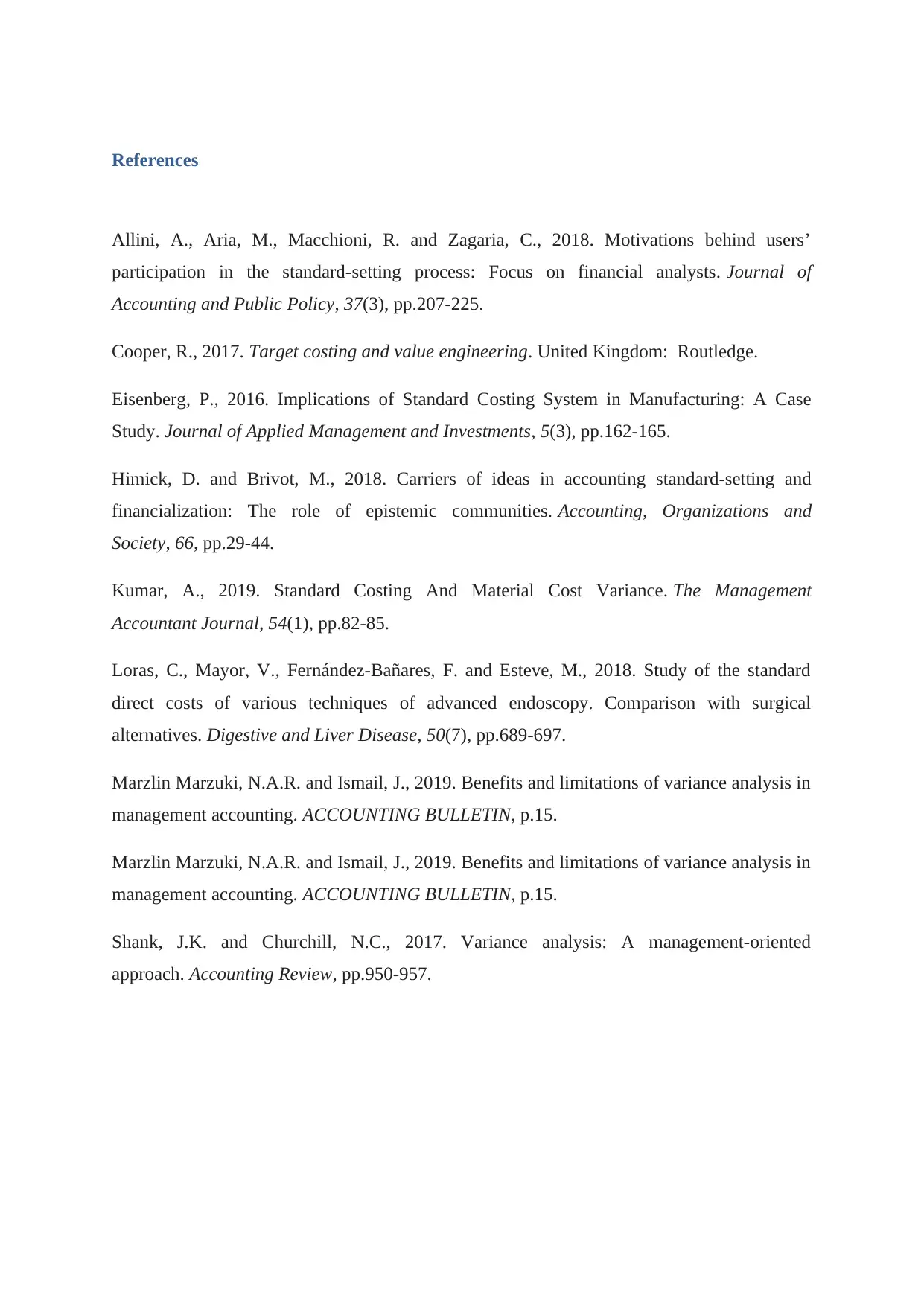
References
Allini, A., Aria, M., Macchioni, R. and Zagaria, C., 2018. Motivations behind users’
participation in the standard-setting process: Focus on financial analysts. Journal of
Accounting and Public Policy, 37(3), pp.207-225.
Cooper, R., 2017. Target costing and value engineering. United Kingdom: Routledge.
Eisenberg, P., 2016. Implications of Standard Costing System in Manufacturing: A Case
Study. Journal of Applied Management and Investments, 5(3), pp.162-165.
Himick, D. and Brivot, M., 2018. Carriers of ideas in accounting standard-setting and
financialization: The role of epistemic communities. Accounting, Organizations and
Society, 66, pp.29-44.
Kumar, A., 2019. Standard Costing And Material Cost Variance. The Management
Accountant Journal, 54(1), pp.82-85.
Loras, C., Mayor, V., Fernández-Bañares, F. and Esteve, M., 2018. Study of the standard
direct costs of various techniques of advanced endoscopy. Comparison with surgical
alternatives. Digestive and Liver Disease, 50(7), pp.689-697.
Marzlin Marzuki, N.A.R. and Ismail, J., 2019. Benefits and limitations of variance analysis in
management accounting. ACCOUNTING BULLETIN, p.15.
Marzlin Marzuki, N.A.R. and Ismail, J., 2019. Benefits and limitations of variance analysis in
management accounting. ACCOUNTING BULLETIN, p.15.
Shank, J.K. and Churchill, N.C., 2017. Variance analysis: A management-oriented
approach. Accounting Review, pp.950-957.
Allini, A., Aria, M., Macchioni, R. and Zagaria, C., 2018. Motivations behind users’
participation in the standard-setting process: Focus on financial analysts. Journal of
Accounting and Public Policy, 37(3), pp.207-225.
Cooper, R., 2017. Target costing and value engineering. United Kingdom: Routledge.
Eisenberg, P., 2016. Implications of Standard Costing System in Manufacturing: A Case
Study. Journal of Applied Management and Investments, 5(3), pp.162-165.
Himick, D. and Brivot, M., 2018. Carriers of ideas in accounting standard-setting and
financialization: The role of epistemic communities. Accounting, Organizations and
Society, 66, pp.29-44.
Kumar, A., 2019. Standard Costing And Material Cost Variance. The Management
Accountant Journal, 54(1), pp.82-85.
Loras, C., Mayor, V., Fernández-Bañares, F. and Esteve, M., 2018. Study of the standard
direct costs of various techniques of advanced endoscopy. Comparison with surgical
alternatives. Digestive and Liver Disease, 50(7), pp.689-697.
Marzlin Marzuki, N.A.R. and Ismail, J., 2019. Benefits and limitations of variance analysis in
management accounting. ACCOUNTING BULLETIN, p.15.
Marzlin Marzuki, N.A.R. and Ismail, J., 2019. Benefits and limitations of variance analysis in
management accounting. ACCOUNTING BULLETIN, p.15.
Shank, J.K. and Churchill, N.C., 2017. Variance analysis: A management-oriented
approach. Accounting Review, pp.950-957.
⊘ This is a preview!⊘
Do you want full access?
Subscribe today to unlock all pages.

Trusted by 1+ million students worldwide
1 out of 6
Related Documents
Your All-in-One AI-Powered Toolkit for Academic Success.
+13062052269
info@desklib.com
Available 24*7 on WhatsApp / Email
![[object Object]](/_next/static/media/star-bottom.7253800d.svg)
Unlock your academic potential
Copyright © 2020–2025 A2Z Services. All Rights Reserved. Developed and managed by ZUCOL.





